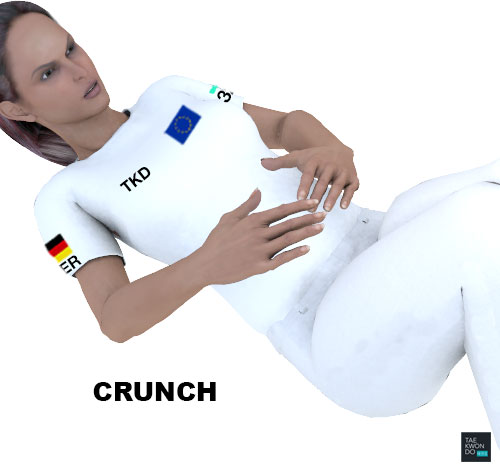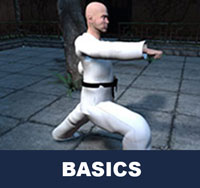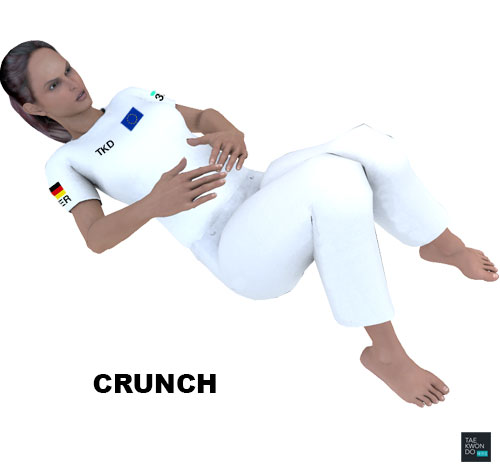Taekwondo 태권도Taekwondo Preschool
When you reach senior belt you are expected to guide the junior belts when they are beginning Taekwondo such as showing by example. To advance from one rank to the next, students typically complete promotion tests in which they demonstrate their proficiency in the various aspects of the art before a panel of judges or their teacher. View Taekwondo belt levels »

About Crunch
The risks and benefits of combining stretching with warming up are disputed, although it is generally believed that warming up prepares the athlete both mentally and physically.
* Please see a certified Master Instructor ( 사범님 sabeomnim ) for training. Proper guidance and instructions are needed to ensure safe training.
The crunch is one of the most common abdominal exercises. It primarily works the rectus abdominis muscle and also works the obliques.
A crunch begins with lying face up on the floor with knees bent. The movement begins by curling the shoulders towards the pelvis. The hands can be behind or beside the neck or crossed over the chest. Injury can be caused by pushing against the head or neck with hands.
The difficulty of the crunch can be increased by lying on a declined bench or holding a weight under the chin, on the chest or behind the head. Crunch exercises may be performed on exercise balls. Increasing the distance will also increase the load on the abdominals due to leverage. The curl-up is taught by spine biomechanics professor Dr. Stuart McGill, and he considers it to be a safer alternative to the crunch, which differs from the sit-up. McGill has done extensive research on the effects of crunch exercises on the back, which can be especially harmful for those rehabilitating their backs from an injury.
Strength exercises such as sit-ups and crunches do not cause the spot reduction of fat. Achieving "six pack abs" requires both abdominal muscle hypertrophy training and fat loss over the abdomen—which can only be done by losing fat from the body as a whole.

Differences between a crunch and a situp
Unlike the sit-up, in a proper crunch, the lower back stays on the floor. This is said by scientific literature to eliminate any involvement by the hip flexors, and make the crunch an effective isolation exercise for the abdominals.
Variations
- The reverse crunch is a crunch done with the upper back on the floor and lifting the hips up instead.
- The twisting crunch is performed by lifting one shoulder at a time. More emphasis is placed on the obliques.
- The Thai crunch is performed by hitting the stomach after full contraction. This variation is used by Muay Thai fighters to condition the core to take hits from punches or knees.
- The cable crunch is performed while kneeling upright by curling the body to pull down on a cable machine. The hips are kept motionless.
Difficulty of Warm-Up Exercise
The risks and benefits of combining stretching with warming up are disputed, although it is generally believed that warming up prepares the athlete both mentally and physically. The more difficult the warm-up, the more practice may be needed for the purpose of improving or mastering it, as in the phrase 'practice makes perfect'.
* Please see a certified Master Instructor ( 사범님 sabeomnim ) for training. Proper guidance and instructions are needed to ensure safe training.

Taekwondo Basics
Here is where you can learn more about Taekwondo 태권도. Knowing the fundamental basics is very important for your learning path as you build your skills and knowledge. There are certain rules that need to be followed to show respect to the master ( 사범님 sabeomnim ), the instructors ( 교사님 gyosannim ), other practitioners and to the martial arts. They vary between schools but many have similar rules and guidelines. For more information View Taekwondo Basics »
Please follow the guidance of a certified Master Instructor or trainer when doing sports related activities. The article provided on this page is information that is widely available on Wikipedia article "Situp". Risk of injury can be reduced by completing an effective warm up consisting of a heart raiser to get your pulse up, followed by sport specific dynamic stretches (stretches whilst moving).
There are five tenets defined in the International Taekwondo Federation (ITF) and several more in World Taekwondo (WT).
Perseverance ( 인내 in-nae ): "One will persevere time and time again until they have achieved a result which is adequate towards what one was trying to achieve." View Taekwondo Tenets »
RESOURCES
This article uses material from the Wikipedia article "Situp", which is released under the Creative Commons Attribution-Share-Alike License 3.0.































